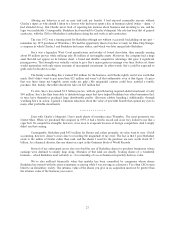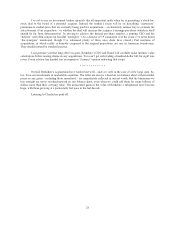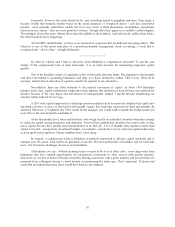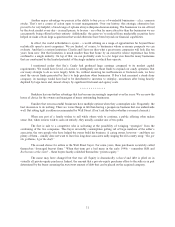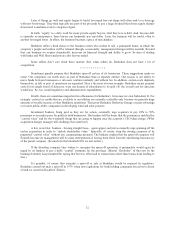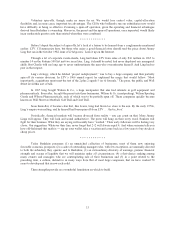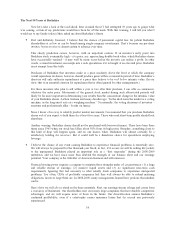Berkshire Hathaway 2014 Annual Report Download - page 29
Download and view the complete annual report
Please find page 29 of the 2014 Berkshire Hathaway annual report below. You can navigate through the pages in the report by either clicking on the pages listed below, or by using the keyword search tool below to find specific information within the annual report.Altering my behavior is not an easy task (ask my family). I had enjoyed reasonable success without
Charlie’s input, so why should I listen to a lawyer who had never spent a day in business school (when – ahem – I
had attended three). But Charlie never tired of repeating his maxims about business and investing to me, and his
logic was irrefutable. Consequently, Berkshire has been built to Charlie’s blueprint. My role has been that of general
contractor, with the CEOs of Berkshire’s subsidiaries doing the real work as sub-contractors.
The year 1972 was a turning point for Berkshire (though not without occasional backsliding on my part –
remember my 1975 purchase of Waumbec). We had the opportunity then to buy See’s Candy for Blue Chip Stamps,
a company in which Charlie, I and Berkshire had major stakes, and which was later merged into Berkshire.
See’s was a legendary West Coast manufacturer and retailer of boxed chocolates, then annually earning
about $4 million pre-tax while utilizing only $8 million of net tangible assets. Moreover, the company had a huge
asset that did not appear on its balance sheet: a broad and durable competitive advantage that gave it significant
pricing power. That strength was virtually certain to give See’s major gains in earnings over time. Better yet, these
would materialize with only minor amounts of incremental investment. In other words, See’s could be expected to
gush cash for decades to come.
The family controlling See’s wanted $30 million for the business, and Charlie rightly said it was worth that
much. But I didn’t want to pay more than $25 million and wasn’t all that enthusiastic even at that figure. (A price
that was three times net tangible assets made me gulp.) My misguided caution could have scuttled a terrific
purchase. But, luckily, the sellers decided to take our $25 million bid.
To date, See’s has earned $1.9 billion pre-tax, with its growth having required added investment of only
$40 million. See’s has thus been able to distribute huge sums that have helped Berkshire buy other businesses that,
in turn, have themselves produced large distributable profits. (Envision rabbits breeding.) Additionally, through
watching See’s in action, I gained a business education about the value of powerful brands that opened my eyes to
many other profitable investments.
************
Even with Charlie’s blueprint, I have made plenty of mistakes since Waumbec. The most gruesome was
Dexter Shoe. When we purchased the company in 1993, it had a terrific record and in no way looked to me like a
cigar butt. Its competitive strengths, however, were soon to evaporate because of foreign competition. And I simply
didn’t see that coming.
Consequently, Berkshire paid $433 million for Dexter and, rather promptly, its value went to zero. GAAP
accounting, however, doesn’t come close to recording the magnitude of my error. The fact is that I gave Berkshire
stock to the sellers of Dexter rather than cash, and the shares I used for the purchase are now worth about $5.7
billion. As a financial disaster, this one deserves a spot in the Guinness Book of World Records.
Several of my subsequent errors also involved the use of Berkshire shares to purchase businesses whose
earnings were destined to simply limp along. Mistakes of that kind are deadly. Trading shares of a wonderful
business – which Berkshire most certainly is – for ownership of a so-so business irreparably destroys value.
We’ve also suffered financially when this mistake has been committed by companies whose shares
Berkshire has owned (with the errors sometimes occurring while I was serving as a director). Too often CEOs seem
blind to an elementary reality: The intrinsic value of the shares you give in an acquisition must not be greater than
the intrinsic value of the business you receive.
27












